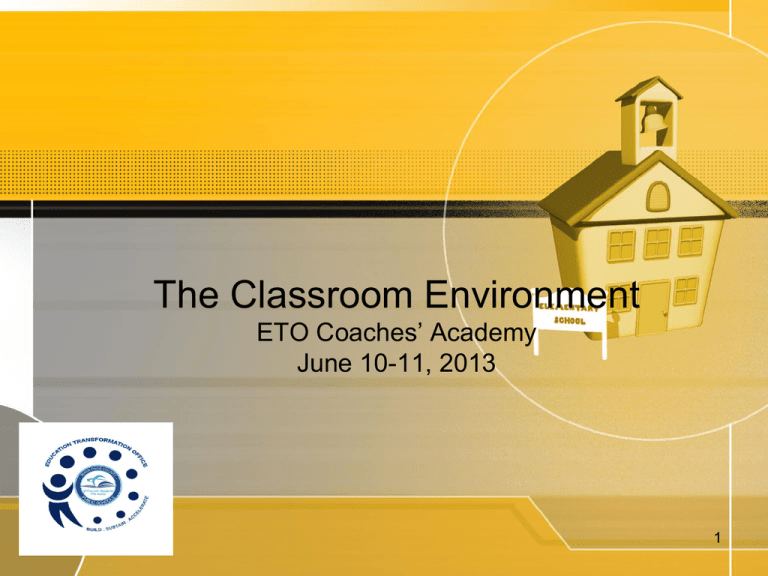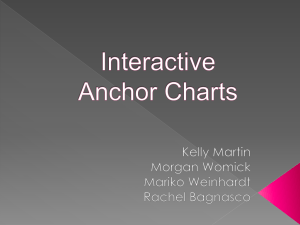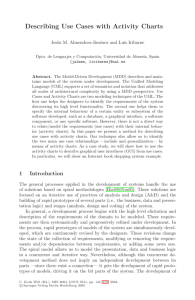Classroom Environment
advertisement

The Classroom Environment ETO Coaches’ Academy June 10-11, 2013 http://sho 1 Common Board Configuration (CBC) DATE: June 11, 2013 VOCABULARY: EXIT SLIP: BELL RINGER: -Classroom Management Analyze Pictorial Depiction -Instructional Framework -Anchor Charts -Expectations •Revisit Essential Question BENCHMARK: Classroom Environment AGENDA: What is an effective classroom environment? –Bell Ringer 3. OBJECTIVE: Participants will I Do: identify and discuss all of the components of an effective classroom environment. ESSENTIAL QUESTION: How does the use of classroom environment support student learning? ORDERof the •PurposeHIGHER and Components QUESTIONS: classroom environment We Do: • How will I ensure that •Identify instructional routines teachers successfully They Do: incorporate collaborative strategies during group of •With a partner, discuss the purpose work? anchor charts You Do: Revisit activity from Bell Ringer – How would you change it? HOME LEARNING: Review today’s lesson and reflect on how you would implement these look-fors if you were a coach next year. Objectives Participants will: • Identify and discuss all of the components of an effective classroom environment. • Evaluate how classroom environment supports student learning. 3 Essential Questions What demonstrates the effective use of the components of classroom environment, and how do they positively enhance instruction? How does the use of classroom environment support student learning? 4 5 What do you see? The Literate Classroom Environment “A classroom environment rich in language and print . . . stimulates authentic learning and promotes the concept of the class as a community of people who are learning together.” Dr. J. David Cooper Classroom Environment Tips Managing classroom procedures Post CBC and review with students the structure/agenda and content of the lesson Gradually implement classroom routines e.g. expectations for entering the classroom, small group procedures, and all transitions. Managing student behavior Use a system that is easy to manage and understand – keep it simple Review and post PBS system Set consequences you can enforce and always follow through ( be firm, fair, and consistent) Organizing materials and furniture Make core and supplemental materials accessible to all students Plan , organize, and set up small group activities Delineate a place for students to work independently and in groups If something isn’t working, reflect and revise! F 8 Elements of Classroom Environment Environmental print includes current student work with descriptive and/or corrective feedback, print featuring aspects of the curriculum under study, student generated word walls, anchor charts, and labeled areas and items throughout the classroom e.g. data walls, student grouping charts, exit tickets, technology, literacy/work stations, and PBS systems. Classroom libraries that include a wide variety of genres representing several cultures and incorporate reading levels on, above, and below grade level and are organized by genre and Lexile. Classroom organization supports literacy by inviting social interaction. Sample Displayed Student Work 10 Sample Anchor Charts Sample Word Walls 12 Sample Grouping Charts 13 Sample Data Wall 14 Sample PBS Systems 15 Sample Classroom Library Libraries MUST BE LEVELED • Lexile • A.R. In addition, you may consider grouping by: • Genre • Theme • Author/Illustrator Sample Exit Ticket 17 Other Print-Rich Elements Class Jobs Essential Questions & Goal Setting for Behavior Continually Create Class Norms/Procedures/Rules Together 18 Literacy learning occurs best in classrooms where: Students find a place for reading, writing, talking, thinking out loud Students are given respectful tasks Skills are taught─ but never to the exclusion of creative activities and spontaneous discussion Reading is approached in multiple ways, and literature includes both whole texts and classics Leila Christenbury, 2007, p. 293 Who is the Good Teacher? in Adolescent Literacy: Turning Promise into Practice 19 Transitions • Transitions are important to smoothly move from one topic to another or from one class to another. • They allow class time to be used effectively and with very little down time. Transitions • Divide class periods into smaller segments to increase student engagement. • Always try to have the next element of the lesson ready to go to ease transitions. • Use multiple methods to get students’ attention and bring everyone back together. Always Plan More than you Need • Boredom can lead to inappropriate behavior • Good for students who learn quickly and can proceed with something new while you review with the others. Always Plan More than you Need • Always have enrichment materials handy • You always need a plan B in case something comes up. Be flexible! Always Plan More than you Need • Technology Plug – Differentiation and enrichment made easier! – Multiple links to activities at various skill levels. Effective Ways to Hand out Resources • Try to avoid having the entire class getting up just to get a specific type of supply. • Setting up stations • Assigning jobs • Totes Multi-Task • This allows better time management. • While you are taking roll, kids can pass out papers, turn in work, finish their assigned task from the previous day, etc. Multi-Task • Use each moment of your class time wisely. • When students are entering the room always have instructions or activities projected on the board. • Use those opening minutes! Pay Attention to Student Cues • This helps you decide the pace of the lesson. • It helps you determine if students are overwhelmed or clearly understanding the lesson. • Chunk material and give time for student discussion. Pay Attention to Student Cues • Check often for student comprehension: – – – – White Board Responses Thumbs up/Down/Middle Journal Responses Student Accountable Talk Be Prepared • Prepare and organize as much as you can ahead of time. Don’t waste class time constructing something unless that is the goal of the activity. Keep class time “sacred”. Be Prepared • Do your best to know your content through and through. Overwhelming at first! • Plan as far ahead as possible. • Find reliable people to learn from! Practice Rituals • Go over and Practice your class rituals with your students so that they know exactly what is expected of them. • Filling out agendas, taking bathroom breaks, sickness, absences… • Routine helps ensure order. Post a Weekly Schedule • Helps absentees know what they missed with very little help from you. • Provides anticipatory set • Adds cohesiveness • Know needed supplies Post a Weekly Schedule • Using a class blog or wiki can help facilitate sharing your schedule with students and families. MOVIES skits Pair and Share JOKES graphic organizers Drawing • Add a variety of learning experiences: visual, movement, songs, games, etc. and you will reach more learning styles • Intersperse these with independent or written activities to assess student learning. • Students will be more involved in your teaching, you will have fewer discipline problems, and they will have better understanding of your lessons. MOVIES skits Pair and Share JOKES graphic organizers Drawing • Make learning fun! – We have one of the greatest jobs in the world. Enjoy it. Encourage a love of learning among your students. Create a Safe Learning Environment • Establish a caring relationship with your students. • Be clear that your room is a safe place to take risks without fear of embarrassment; maintain student dignity. Create a Safe Learning Environment • Do team building activities at the beginning of the year to give students a sense of belonging • Use humor to diffuse tense situations. • Let students know that you aren’t perfect either. • Mistakes are sometimes the best way to learn. Have High Expectations • Expect students to follow rules. Nail down rules from the first day and take time to “practice” if they “forget”. • Expect 100% effort even if something is hard! Have High Expectations • Expect effective communication skills • Expect students to be responsible for their own choices. • Students will live up to or down to expectations. Revisit E.Q. What demonstrates the effective use of the components of classroom environment, and how do they positively enhance instruction? How does the use of classroom environment support student learning? How does the classroom environment support the effective implementation of the instructional framework? 41 Ice Breaker… What do you see? Bringing it all Together How can an individual assess consistent instruction by examining one’s classroom environment? How will you assist teachers in creating a classroom environment that supports student learning? How will you build capacity among teachers to enhance instruction and create literacy based classroom environments?









